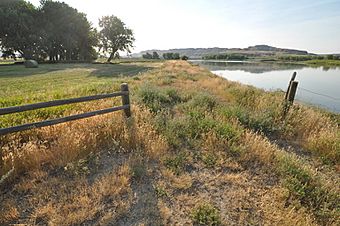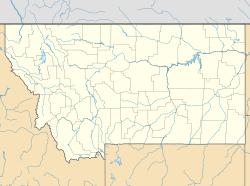Judith Landing Historic District facts for kids
|
Judith Landing Historic District
|
|
 |
|
| Location | Dog Creek Road, Upper Missouri River Breaks National Monument, near Winifred, Montana |
|---|---|
| Area | 9,555 acres (38.67 km2) |
| NRHP reference No. | 75001081 (original) 14000143 (increase) |
Quick facts for kids Significant dates |
|
| Added to NRHP | December 6, 1975 |
| Boundary increase | April 11, 2014 |
The Judith Landing Historic District is a very important historical area in Montana. It's located near the town of Winifred, Montana. This special district was added to the National Register of Historic Places in 1975.
It's a huge area, covering about 9,555 acres (that's over 38 square kilometers!). The district stretches across parts of Chouteau and Fergus counties. It includes where the Judith River and Dog Creek meet the mighty Missouri River.
Contents
Judith Landing: A Place of Firsts and History
The Judith Landing Historic District is a rugged and beautiful place. It has tall, dry bluffs, small creeks, and green river bottoms. This area is famous for many reasons. It holds clues to the past, from ancient times to more recent history.
First Dinosaur Discovery
One of the most exciting things about this district is the Hayden Site. In 1855, a scientist named Ferdinand Vandeveer Hayden made an amazing discovery here. He found the very first dinosaur bones and teeth in the Western Hemisphere! This was a huge moment for science.
After Hayden's discovery, other scientists came to explore. Expeditions in 1875, 1876, and 1914 also found more fossils. They continued to study the dinosaur beds first found by Hayden.
Lewis and Clark's Visit
The Judith Landing area was also visited by the famous Lewis and Clark Expedition. On May 28, 1805, the Corps of Discovery camped here. This was a key stop on their journey to explore the American West.
Other Important Events
This historic district has seen many other important events:
- Fort Chardon Trading Post: A trading post was here from 1844 to 1845.
- Isaac Stevens' Treaty: In 1855, the Lame Bull Treaty was signed here.
- Camp Cooke: This was the first military post in Montana, active from 1866 to 1870.
- PN Cable Ferry: A ferry operated here from 1880 to 1908, helping people cross the river.
The land on the south side of the river was once a huge cattle ranch. It was started by a merchant named T.C. Power and managed by John Norris.
Today's Recreation Area
Today, the Judith Landing Historic District is also a popular recreation area. It's located between Winifred and Big Sandy, Montana. There's a campground for visitors. Many boaters use it as a place to start or finish their trips along the Missouri River. It's a great spot to enjoy nature and learn about history.
The district was expanded in 2014. This added even more land to protect its important historical and archaeological sites. These sites are valuable because they can teach us so much about the past.


